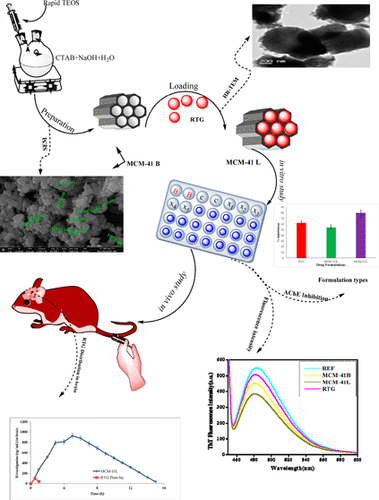当前位置:
X-MOL 学术
›
ACS Biomater. Sci. Eng.
›
论文详情
Our official English website, www.x-mol.net, welcomes your feedback! (Note: you will need to create a separate account there.)
MCM-41 Nanoparticles for Brain Delivery: Better Choline-Esterase and Amyloid Formation Inhibition with Improved Kinetics
ACS Biomaterials Science & Engineering ( IF 5.8 ) Pub Date : 2018-07-09 00:00:00 , DOI: 10.1021/acsbiomaterials.8b00335 Pawan K. Pandey , Ashok K. Sharma , Sarita Rani , Gaurav Mishra , Gopal Kandasamy 1 , Ajit K. Patra , Monika Rana , Anuj K. Sharma , Awesh K. Yadav 2 , Umesh Gupta
ACS Biomaterials Science & Engineering ( IF 5.8 ) Pub Date : 2018-07-09 00:00:00 , DOI: 10.1021/acsbiomaterials.8b00335 Pawan K. Pandey , Ashok K. Sharma , Sarita Rani , Gaurav Mishra , Gopal Kandasamy 1 , Ajit K. Patra , Monika Rana , Anuj K. Sharma , Awesh K. Yadav 2 , Umesh Gupta
Affiliation

|
The present study was aimed at delivering a low bioavailability drug, rivastigmine hydrogen tartrate (RTG), to the brain through its encapsulation in mesoporous silica nanoparticles (MSNs) and targeted to amyloid inhibition in the brain. MSNs were characterized for size, zeta potential, and drug entrapment using SEM, TEM, HR-TEM, FT-IR, and PXRD. Drug-loaded MSNs were assessed for in vitro release kinetics and ex vivo followed by animal studies. The average size of the prepared blank (MCM-41B) and drug-loaded MSNs (MCM-41L) was 114 ± 2.0 and 145 ± 0.4 nm with the zeta potential of approximately −43.5 ± 1.1 and −37.6 ± 1.4 mV, respectively. MCM-41L exhibited an average entrapment efficiency of 88%. In vitro release studies exhibited early surge followed by a sluggish persistent or constant release (biphasic pattern). Hemolytic studies proved that the developed MCM-41L NPs are less hemolytic compared to RTG. A reduced ThT fluorescence was observed with MCM-41L compared to MCM-41B and RTG in the amyloid inhibition studies. A significant (p < 0.05) inhibition of AChE (acetycholinesterase) was observed for MCM-41L (80 ± 4.98%), RTG (62 ± 3.25%), and MCM-41B (54 ± 4.25%). In vivo pharmacokinetics in Wistar rats revealed that the AUC and mean residence time (MRT) for MCM-41L was sustained and significantly higher (p < 0.05) (780 ± 3.30 ng/L; 5.49 ± 0.25 h) compared to RTG solution (430 ± 3.50 ng/L; 0.768 ± 0.17 h). Similarly, the half-life was found to be significantly higher in case of MCM-41L. The promising result was brain delivery of RTG in Wistar rats which was enhanced almost 127 folds in vivo, using MCM-41L nanoparticles. MCM-41L nanoparticles effectively enhanced the bioavailability of RTG. Conclusively, these can be used for the administration of RTG and other related low bioavailability drugs for improved brain delivery.
中文翻译:

MCM-41用于脑部递送的纳米颗粒:具有改善的动力学的更好的胆碱酯酶和淀粉样蛋白形成抑制
本研究旨在通过将其包裹在中孔二氧化硅纳米颗粒(MSNs)中,将低生物利用度药物酒石酸氢氧他司汀明(RTG)输送至大脑,并靶向抑制淀粉样蛋白。使用SEM,TEM,HR-TEM,FT-IR和PXRD对MSN的大小,ζ电位和药物截留进行了表征。评估载药MSN的体外释放动力学和离体,然后进行动物研究。制备的空白(MCM-41B)和载药MSN(MCM-41L)的平均大小分别为114±2.0和145±0.4 nm,ζ电位分别约为-43.5±1.1和-37.6±1.4 mV。MCM-41L的平均包封效率为88%。体外释放研究显示早期激增,随后缓慢或持续释放(双相型)。溶血研究证明,与RTG相比,已开发的MCM-41L NP溶血较少。在淀粉样蛋白抑制研究中,与MCM-41B和RTG相比,MCM-41L观察到ThT荧光降低。重大(p观察到MCM-41L(80±4.98%),RTG(62±3.25%),和MCM-41B(54±4.25%)<0.05)的AChE(乙酰胆碱酯酶的抑制)。Wistar大鼠的体内药代动力学显示,与RTG溶液(430)相比,MCM-41L的AUC和平均停留时间(MRT)持续且显着更高(p <0.05)(780±3.30 ng / L; 5.49±0.25 h) ±3.50 ng / L; 0.768±0.17 h)。同样,发现MCM-41L的半衰期明显更长。令人鼓舞的结果是使用MCM-41L纳米颗粒将Wistar大鼠的RTG大脑递送到体内后提高了将近127倍。MCM-41L纳米颗粒可有效提高RTG的生物利用度。结论是,这些可用于RTG和其他相关的生物利用度低的药物,以改善大脑的传递。
更新日期:2018-07-09
中文翻译:

MCM-41用于脑部递送的纳米颗粒:具有改善的动力学的更好的胆碱酯酶和淀粉样蛋白形成抑制
本研究旨在通过将其包裹在中孔二氧化硅纳米颗粒(MSNs)中,将低生物利用度药物酒石酸氢氧他司汀明(RTG)输送至大脑,并靶向抑制淀粉样蛋白。使用SEM,TEM,HR-TEM,FT-IR和PXRD对MSN的大小,ζ电位和药物截留进行了表征。评估载药MSN的体外释放动力学和离体,然后进行动物研究。制备的空白(MCM-41B)和载药MSN(MCM-41L)的平均大小分别为114±2.0和145±0.4 nm,ζ电位分别约为-43.5±1.1和-37.6±1.4 mV。MCM-41L的平均包封效率为88%。体外释放研究显示早期激增,随后缓慢或持续释放(双相型)。溶血研究证明,与RTG相比,已开发的MCM-41L NP溶血较少。在淀粉样蛋白抑制研究中,与MCM-41B和RTG相比,MCM-41L观察到ThT荧光降低。重大(p观察到MCM-41L(80±4.98%),RTG(62±3.25%),和MCM-41B(54±4.25%)<0.05)的AChE(乙酰胆碱酯酶的抑制)。Wistar大鼠的体内药代动力学显示,与RTG溶液(430)相比,MCM-41L的AUC和平均停留时间(MRT)持续且显着更高(p <0.05)(780±3.30 ng / L; 5.49±0.25 h) ±3.50 ng / L; 0.768±0.17 h)。同样,发现MCM-41L的半衰期明显更长。令人鼓舞的结果是使用MCM-41L纳米颗粒将Wistar大鼠的RTG大脑递送到体内后提高了将近127倍。MCM-41L纳米颗粒可有效提高RTG的生物利用度。结论是,这些可用于RTG和其他相关的生物利用度低的药物,以改善大脑的传递。


























 京公网安备 11010802027423号
京公网安备 11010802027423号